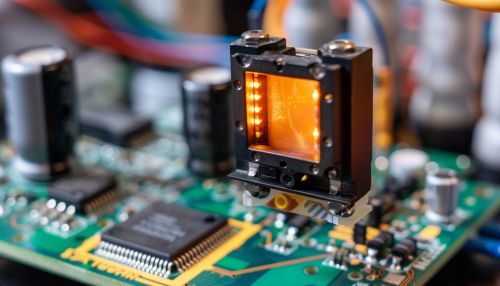Infrared Sensor
Introduction
An infrared sensor is a device that measures and detects infrared radiation in its surrounding environment. Infrared radiation, a type of electromagnetic radiation, is invisible to the human eye but can be felt as heat. Infrared sensors are widely used in various applications, from home security systems to mobile phones and even medical devices.


Principle of Operation
Infrared sensors operate based on the principle of infrared radiation, which is emitted by all objects that have a temperature above absolute zero. The sensor measures the radiation and converts it into an electrical signal, which can then be interpreted by a microcontroller or other processing device.
There are two types of infrared sensors: passive and active. Passive infrared sensors (PIR) detect emitted infrared radiation, while active infrared sensors emit infrared radiation and then detect the reflection.
Types of Infrared Sensors
There are several types of infrared sensors, each with its own specific uses and advantages.
Passive Infrared Sensors
Passive infrared sensors (PIR) are the most common type of infrared sensor. They work by detecting the infrared radiation emitted by objects in their field of view. PIR sensors are often used in motion detection systems, such as security alarms and automatic lighting systems.
Active Infrared Sensors
Active infrared sensors work by emitting an infrared signal and then measuring the reflection. This type of sensor is often used in obstacle detection systems, such as those found in autonomous vehicles and robotics.
Thermal Infrared Sensors
Thermal infrared sensors measure the temperature of objects by detecting the infrared radiation they emit. These sensors are often used in thermal imaging systems, such as those used by firefighters to see through smoke, or in medical imaging to detect abnormalities in body temperature.
Near Infrared Sensors
Near infrared sensors operate in the near-infrared spectrum, just beyond the visible light spectrum. These sensors are often used in spectroscopy and chemical analysis, as different substances will absorb and reflect near-infrared light in different ways.
Applications of Infrared Sensors
Infrared sensors have a wide range of applications in various fields.
Security Systems
Infrared sensors are commonly used in security systems, where they can detect movement by sensing changes in the infrared radiation in an area. This can be used to trigger an alarm or turn on lights when movement is detected.
Medical Devices
Infrared sensors are used in a variety of medical devices, such as pulse oximeters, which measure the oxygen saturation in a patient's blood by detecting the absorption of infrared light.
Environmental Monitoring
Infrared sensors can be used to monitor environmental conditions, such as temperature and humidity, by detecting the infrared radiation emitted by the environment.
Industrial Automation
In industrial automation, infrared sensors are used for tasks such as object detection, distance measurement, and temperature monitoring.
Advantages and Limitations
Infrared sensors have several advantages, including their ability to operate in low light conditions and their non-contact nature, which allows them to measure or detect objects without physically touching them. However, they also have some limitations, such as their sensitivity to environmental conditions like temperature and humidity, and the fact that they can be affected by obstacles that block the path of the infrared radiation.
Conclusion
Infrared sensors are a versatile and widely used technology, with applications in many different fields. Despite their limitations, their ability to detect and measure infrared radiation makes them an invaluable tool in many different contexts.
